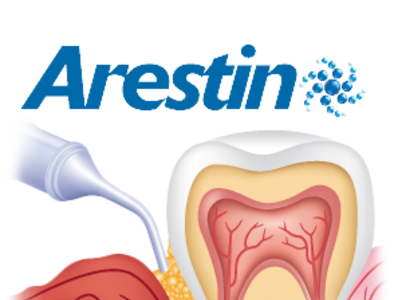Protect Yourself
Everyone knows what menace tooth decay can cause, but periodontal disease has a more illustrious reputation: It’s the number one cause for tooth loss in America.
When coupled with regular dental visits, good oral hygiene habits provide an effective defense against gingivitis and gum disease. But diligence is crucial; since dental plaque only takes 26 hours to build up, skipping just one day of brushing and flossing can be more harmful than you might think. Smoking, hormonal changes and certain medication can also increase the risk of periodontal disease.
So what if periodontal disease has already set in? Most dentists or periodontists will recommend a gum disease treatment known as scaling and root planing (SRP). While SRPs have been used to treat periodontal disease for many years, recent clinical studies prove that the adjunct use of the antibiotic ARESTIN packs a one-two punch that a SRP alone can’t provide.
Arrested Development
Available in powder form, ARESTIN is a tasteless antibiotic that’s placed inside infected periodontal pockets following a SRP procedure. Minocycline, the active ingredient in ARESTIN, is contained within bead-like particles (microspheres) that release the drug for up to 21 days after SRP treatment.
On its own, a SRP treatment may not be entirely successful in removing all the bacteria associated with periodontal disease — especially the bacteria that live deep within periodontal pockets or in hard-to-reach areas — so the use of ARESTIN adds an extra dimension of protection.
In addition, when used as part of a maintenance program, ARESTIN reduces the size of periodontal pockets and helps heal bleeding gums that can occur when gums are probed.
After Care
For optimal results following an SRP procedure, be sure to follow the specific post-op instructions provided by your dentist. The makers of ARESTIN also recommend the following general guidelines:
- Avoid touching areas of your gums that your dental professional has treated.
- Wait 12 hours after treatment before brushing your teeth.
- Wait 10 days before using floss, toothpicks, or other devices designed to clean between teeth in the areas that were treated with ARESTIN.
- Avoid eating hard, crunchy, or sticky foods (such as popcorn, caramel, etc.) for 1 week after dental treatment.
- Be sure to return for your follow-up appointments, since gum disease can recur and gums need to be checked regularly.
Is ARESTIN for You?
While many patients can benefit from the use of ARESTIN, if you have a known allergy or sensitivity to minocycline or tetracycline you should notify your dentist prior to receiving an SRP treatment. Children, expecting mothers and nursing mothers should also refrain from using ARESTIN. But remember, the best way to find out if ARESTIN is safe for you is to talk to your dentist.

